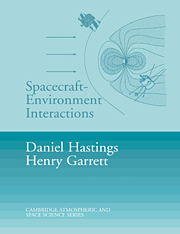Book contents
- Frontmatter
- Contents
- List of Illustrations
- List of Tables
- Preface
- Acknowledgment
- 1 Introduction
- 2 Fundamental Length, Time, and Velocity Scales
- 3 The Ambient Space Environment
- 4 Neutral Gas Interactions
- 5 Plasma Interactions
- 6 The Space Radiation Environment
- 7 Particulate Interactions
- 8 The State of the Art
- References
- Index
4 - Neutral Gas Interactions
Published online by Cambridge University Press: 30 September 2009
- Frontmatter
- Contents
- List of Illustrations
- List of Tables
- Preface
- Acknowledgment
- 1 Introduction
- 2 Fundamental Length, Time, and Velocity Scales
- 3 The Ambient Space Environment
- 4 Neutral Gas Interactions
- 5 Plasma Interactions
- 6 The Space Radiation Environment
- 7 Particulate Interactions
- 8 The State of the Art
- References
- Index
Summary
For spacecraft in LEO and PEO, the dominant environment is the ambient neutral atmosphere. The neutral gases that make up the atmosphere in this environment form a distinctive structure around the spacecraft and give rise to drag, surface erosion, and spacecraft glow. The neutral gases emitted by the spacecraft itself give rise to contamination on other parts of the spacecraft. In this chapter, these interactions are systematically evaluated. Primary emphasis is on the physics of the flows associated with the interactions.
Neutral Gas Flow Around a Spacecraft
For a spacecraft in a LEO or PEO, the ambient mean free path for momentum exchange is given by Eq. (2.38). With a typical elastic scattering cross section of O (10−20 m2) and with mean densities around the orbit from Table 3.4, the ambient mean free path is of the order of many kilometers. This is illustrated in Figure 4.1 for profiles of the number density, collision frequency, mean free path, and particle speed from the surface to 700 km for the U.S. Standard Atmosphere. Where the Knudsen number [see Eq. (2.39)] satisfies Kn ≫ 1, the flow of ambient neutral gas around the spacecraft is collisionless. Since from Table 3.4, the gas temperature is typically hundreds to thousands of degrees Kelvin, the thermal velocity is of the order of 700 m/s. For an orbital velocity of 8 km/s, the speed ratio (Section 2.3.2) satisfies S ≫ 1. Therefore, the ambient neutral gas flow around spacecraft in a near Earth orbit will be collisionless and supersonic.
- Type
- Chapter
- Information
- Spacecraft-Environment Interactions , pp. 100 - 141Publisher: Cambridge University PressPrint publication year: 1996



